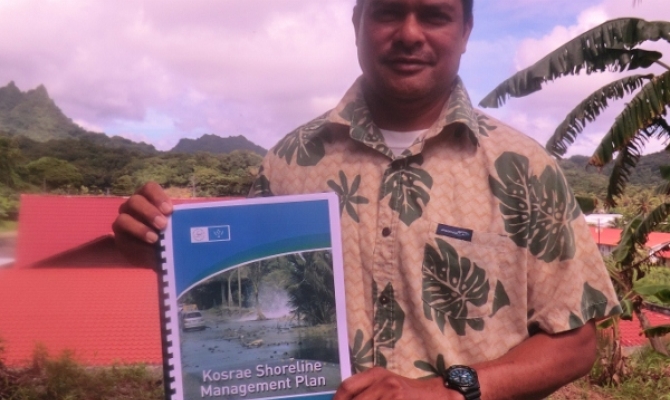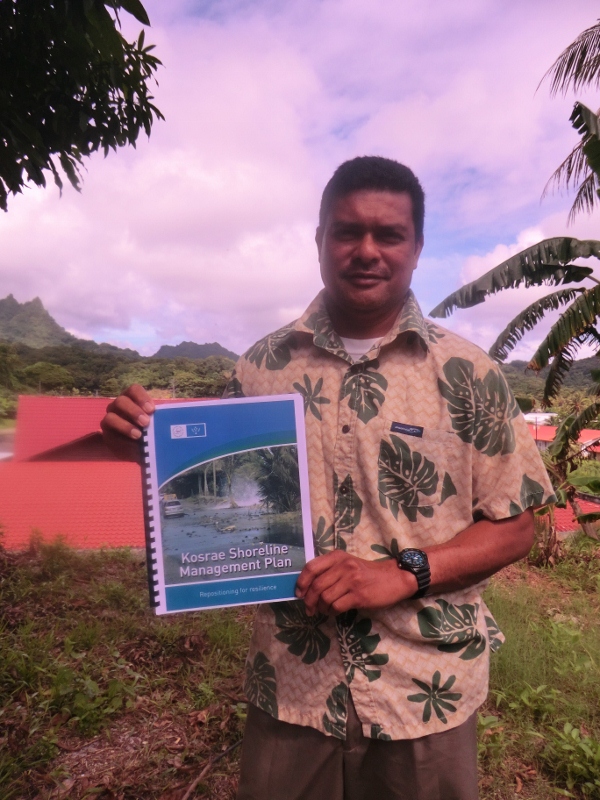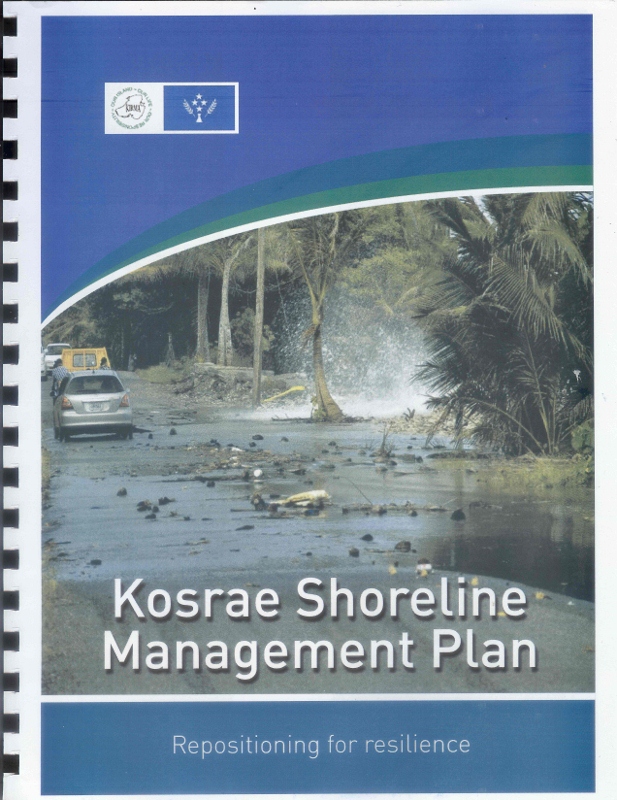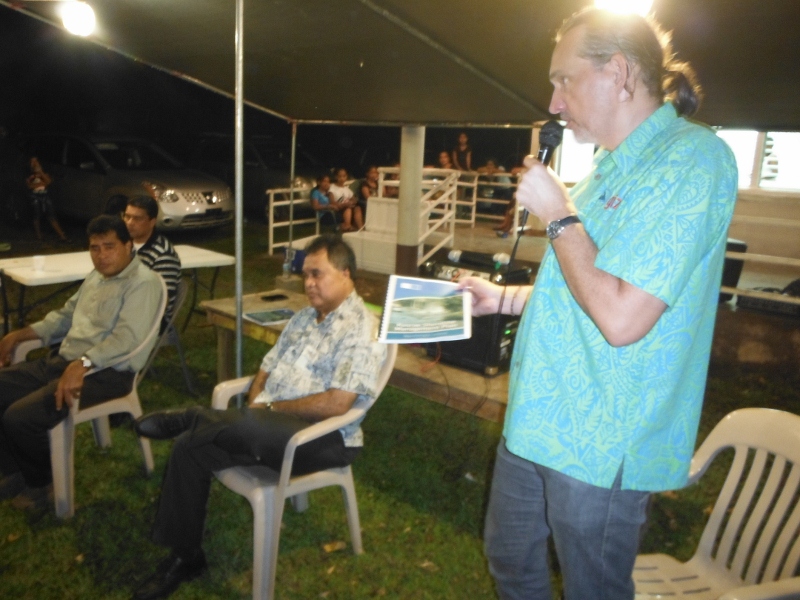
Climate Change Resilience
The Pacific Adaptation to Climate Change Project in Kosrae, Federated States of Micronesia is climate proofing coastal roads with new hydraulic design features that take into account flooding risks from increased rainfall and sea level rise.
This five year project will also develop climate proofing guidelines for road infrastructure, which will be used during implementation of the updated Kosrae Shoreline Management Plan that was presented to Governor Honorable Lyndon H. Jackson in March this year.
One of the recommendations in this Plan was to rehabilitate and improve the existing farm roads on Kosrae to provide an alternative to the coastal roads.
In April last year, Mr. Doug Ramsay of the National Institute of Water and Atmospheric Research in New Zealand, presented the varied impacts of coastal erosion and some adaptation strategies to make Kosrae more resilient to expected changes in the future. It was explained that extreme changes are not expected in two generations, but Kosrae should nonetheless begin preparing now.
This is what the PACC project is doing in Kosrae, helping the people prepare now.
“We’re modifying the coastal road so the drainage can accommodate hourly rainfall events of 254mm and above but this is just some of the work that we are doing to address climate change impacts in Kosrae,” said Simpson Abraham, the PACC Project Manager in Kosrae.
“This project has helped draft climate proofing legislation, installed sea-level and climate monitoring equipment, helped improve the coastal road, as well as developed guidelines that we can now use in other activities on Kosrae.”
According to PACC country reports for FSM, the current coastal road designs on Kosrae are based on estimation that over the next 25 years the road would receive maximum hourly rainfall events of approximately 17cm (7 inches), however the anticipated rainfall by 2050 is anticipated to increase even further to around 25cm (10 inches) per hour due to climate change.
“We are pleased that this project will be strengthened by the recommendations in the Kosrae Shoreline Management Plan such as the rehabilitation and improvement of the farm roads on Kosrae so we have an alternative to the coastal road. When it comes to adaptation and helping to make life better for our people here the more that can be done the better,” said Mr Abraham.
The Kosrae Shoreline Management Plan, which was first developed in 2000, was updated in 2012 and endorsed this year.
The PACC Programme is a partnership between several key regional agencies and national agencies and communities in 14 Pacific island countries. It is funded by the Global Environment Facility (GEF) and the Australian Government, with the United Nations Development Programme (UNDP) as its implementing agency and the Secretariat of the Pacific Regional Environment Programme (SPREP) as implementing partner. The Project is supported by the United Nations Institute for Training and Research (UNITAR) C3D+programme.
The Kosrae Shoreline Management Plan was funded by the German Technical Cooperation Agency, GIZ and the Secretariat of the Pacific Community North Pacific.
*The document can be downloaded here: Kosrae Shoreline Management Plan



From top left: Mr. Simpson Abraham; The Kosrae Shoreline Management Plan; Presentation of The Kosrae Shoreline Management Plan by Mr Fenno Brunken, a Climate Change advisor with GIZ.
This five year project will also develop climate proofing guidelines for road infrastructure, which will be used during implementation of the updated Kosrae Shoreline Management Plan that was presented to Governor Honorable Lyndon H. Jackson in March this year.
One of the recommendations in this Plan was to rehabilitate and improve the existing farm roads on Kosrae to provide an alternative to the coastal roads.
In April last year, Mr. Doug Ramsay of the National Institute of Water and Atmospheric Research in New Zealand, presented the varied impacts of coastal erosion and some adaptation strategies to make Kosrae more resilient to expected changes in the future. It was explained that extreme changes are not expected in two generations, but Kosrae should nonetheless begin preparing now.
This is what the PACC project is doing in Kosrae, helping the people prepare now.
“We’re modifying the coastal road so the drainage can accommodate hourly rainfall events of 254mm and above but this is just some of the work that we are doing to address climate change impacts in Kosrae,” said Simpson Abraham, the PACC Project Manager in Kosrae.
“This project has helped draft climate proofing legislation, installed sea-level and climate monitoring equipment, helped improve the coastal road, as well as developed guidelines that we can now use in other activities on Kosrae.”
According to PACC country reports for FSM, the current coastal road designs on Kosrae are based on estimation that over the next 25 years the road would receive maximum hourly rainfall events of approximately 17cm (7 inches), however the anticipated rainfall by 2050 is anticipated to increase even further to around 25cm (10 inches) per hour due to climate change.
“We are pleased that this project will be strengthened by the recommendations in the Kosrae Shoreline Management Plan such as the rehabilitation and improvement of the farm roads on Kosrae so we have an alternative to the coastal road. When it comes to adaptation and helping to make life better for our people here the more that can be done the better,” said Mr Abraham.
The Kosrae Shoreline Management Plan, which was first developed in 2000, was updated in 2012 and endorsed this year.
The PACC Programme is a partnership between several key regional agencies and national agencies and communities in 14 Pacific island countries. It is funded by the Global Environment Facility (GEF) and the Australian Government, with the United Nations Development Programme (UNDP) as its implementing agency and the Secretariat of the Pacific Regional Environment Programme (SPREP) as implementing partner. The Project is supported by the United Nations Institute for Training and Research (UNITAR) C3D+programme.
The Kosrae Shoreline Management Plan was funded by the German Technical Cooperation Agency, GIZ and the Secretariat of the Pacific Community North Pacific.
*The document can be downloaded here: Kosrae Shoreline Management Plan



From top left: Mr. Simpson Abraham; The Kosrae Shoreline Management Plan; Presentation of The Kosrae Shoreline Management Plan by Mr Fenno Brunken, a Climate Change advisor with GIZ.